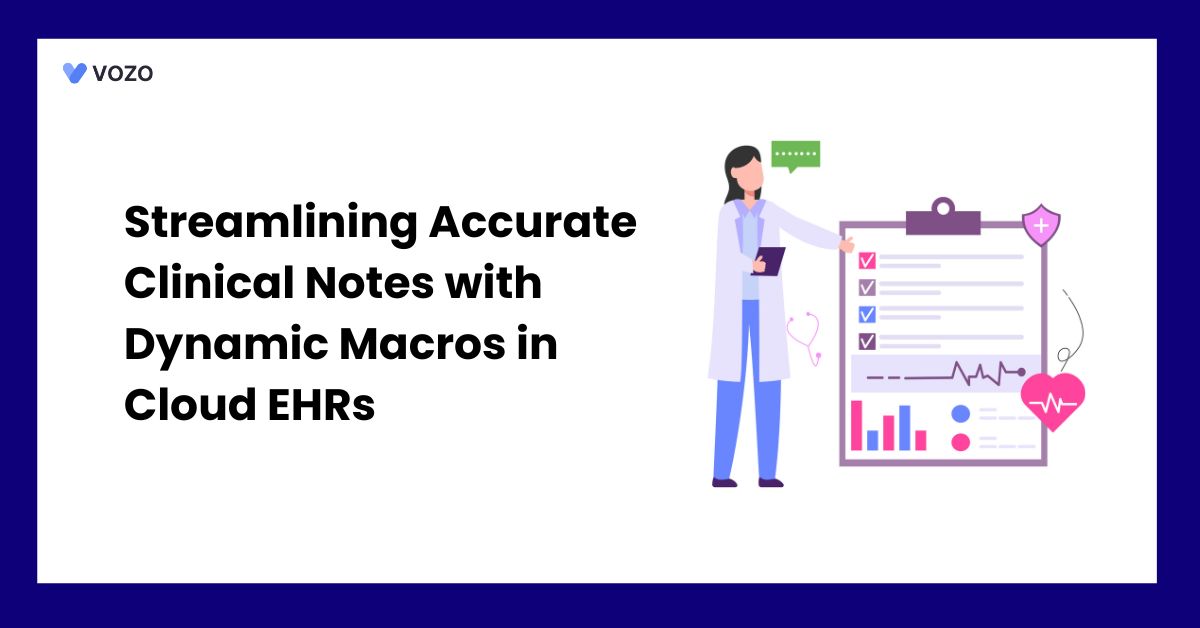Streamlining Accurate Clinical Notes with Dynamic Macros in Cloud EHRs
Efficient, accurate documentation is a critical yet time-consuming part of modern healthcare. Studies show physicians spend a large portion of their day on charting: for example, one analysis found physicians devote roughly 35% of their time to documenting patient data.
Primary care providers often spend more time in the electronic health record than face-to-face with patients, one report found 36.2 minutes of EHR time for every 30-minute visit.
With nearly half of total work hours spent on EHR and desk work, reducing documentation burden is paramount. Dynamic macros, smart, customizable shortcuts, and templates in cloud-based EHRs are revolutionizing how clinicians write notes.
By automating repetitive entries, adapting to patient-specific data, and enforcing structured content, dynamic macros help clinicians complete charting faster and more consistently.
What Are Dynamic Macros?
In EHRs, a macro is a saved command or text block that expands into common documentation when triggered. A dynamic macro takes this further by adapting to the context: it might include fillable fields, drop-down menus, or data placeholders that pull in patient-specific information.
- A dynamic macro can automatically insert the patient’s name, age, or last lab results into a progress note, or prompt the user to fill in the side of the body involved.
- By combining pre-written text with variable fields, dynamic macros create customized notes on the fly.
- This means clinicians can enter complex information with just a few keystrokes or a voice command, rather than typing everything manually.
In cloud-based EHRs, these macros reside on the central platform, so every provider sees the same set of templates, and any updates apply immediately across the system.
Related: 7 Smart Ways to Use Macros in EHR for Faster Clinical Documentation
The Documentation Challenge
Clinical documentation is not only voluminous but also prone to variation and error. In busy practices, notes can become lengthy and inconsistent, risking key details being overlooked. Studies consistently highlight the imbalance between patient care time and documentation.
- An observational study of over 430 hours of physician work found that only 29% of total time was spent talking with patients, whereas 49% was on EHRs and paperwork.
- Other surveys confirm that many doctors feel overwhelmed by charting.
- One report noted that over 80% of surveyed physicians agreed “documenting on paper is faster than on the EHR,” and 71% said documentation time had increased with EHRs.
This documentation burden contributes to frustration and burnout, underscoring the need for better tools. Dynamic macros address these challenges by making note entry more efficient and standardized.
Cloud EHRs Enable Dynamic Macros
Because dynamic macros involve both storage and logic, they benefit from the cloud-based EHR environment. In a cloud EHR, macros and templates are stored centrally and delivered on demand to any authorized user, rather than tied to a single workstation. This offers several advantages:
1. Always Current
Cloud EHR vendors can push new macros and template updates automatically. No downtime or manual installs are needed. In one cloud platform, for example, automated updates ensure the system is “always up to date” whenever a clinician logs in. This means if evidence or billing rules change, updated macros appear immediately across the organization.
2. Anywhere Access
Clinicians working across multiple clinics or on mobile devices see the same macros. A doctor can create or edit a macro at home or office, and it’s instantly available on the hospital’s EHR system. This supports telehealth and multi-site practices seamlessly.
3. Resource Offloading
With cloud hosting, practices don’t need local IT resources to manage macros. The vendor handles backups, uptime, and updates. Clinicians simply log in via a browser. In short, cloud EHRs eliminate hardware hassles and let providers focus on using macros, not supporting them.
4. Integrated Workflow
Cloud EHRs often include built-in libraries of templates and macros for common workflows. Some systems advertise hundreds of ready-made forms that users can further customize. The cloud delivery ensures these resources don’t slow down on-premise networks and can scale with practice size.
Together, these cloud features mean dynamic macros are not just powerful, but also practical and scalable. One analysis of cloud EHR adoption noted that systems “streamline clinical workflows and eliminate the need for copying and pasting patient data between different software systems,” with comprehensive features integrated into one platform.
Related: 10 Ways Custom EHR Macros Can Save You Time
Key Benefits of Dynamic Macros
- Time Savings: Automating repetitive text entry and data insertion slashes documentation time. Clinicians can write notes with a few keystrokes or voice commands instead of typing entire narratives.
- Improved Accuracy: Standardized macros reduce typos, ensure correct terminology, and include mandatory fields to avoid omissions. This yields cleaner, error-free notes.
- Consistency of Notes: Shared macros help align documentation across providers. Every patient note follows the same outline and phrasing, improving clarity. In studies, structured notes scored significantly higher in quality than free-text notes.
- Customization & Flexibility: Clinicians tailor macros to their specialty and preferences. One-click templates and dynamic fields let providers document exactly what they want, while still benefiting from structure.
- Enhanced Satisfaction & Burnout Reduction: By reducing tedious EHR tasks, macros let providers spend more time on patient care. Many doctors report that efficient note-taking tools help decrease frustration. For example, pairing macros with speech recognition can make dictation flow more naturally.
- Better Compliance & Data Reuse: Consistent documentation aids billing, coding, and quality reporting. Structured notes make data easier to extract for registries or analytics, improving overall care management.
Vozo EHR for your Healthcare Practices
From managing and organizing patient health records digitally to reducing medical errors, it significantly empowers providers to improve healthcare quality.
If you are searching for the best EHR system for your healthcare practice, Vozo EHR can be your go-to choice. Our comprehensive EHR solution lets you focus more on patient care while carrying all the burdens and simplifying it.
- Vozo Cloud EHR’s cost-effective cloud subscription benefits all levels of practice.
- Our feature-rich EHR helps you rectify mistakes efficiently and speed up the process.
- Vozo Specialty EHR resonates with specialty practice needs and requirements.
- Our expert technical team has got you covered 24/7 if any needs arise.
- Our EHR System continues to scale as your healthcare practice grows to improve the user experience.
The Vozo Customized EHR solution benefits your healthcare practice by:
- Streamlining the administrative process
- Improving workflow efficiency
- Reducing proneness to errors
- Managing all the patients’ records in one place
- Offers greater efficiency and cost savings across the board.
Our specialty-specific tools, such as scheduling, patient portals, lab integration, cloud hosting, and more, meet the specific needs and requirements of your healthcare practice.
“Embrace Vozo EHR to reduce your burdens and enhance patient care.”
About the author

With more than 4 years of experience in the dynamic healthcare technology landscape, Sid specializes in crafting compelling content on topics including EHR/EMR, patient portals, healthcare automation, remote patient monitoring, and health information exchange. His expertise lies in translating cutting-edge innovations and intricate topics into engaging narratives that resonate with diverse audiences.













